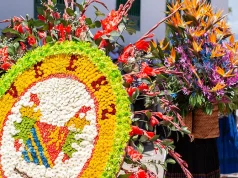
Travelling through Japan by train is more than just a way to get from A to B. It’s a journey through diverse landscapes, a window into local life, and in many cases, an experience worth planning your itinerary around. While the country is rightly known for its high-speed Shinkansen, it’s the slower, scenic routes that often leave the strongest impressions.
Why Train Travel in Japan Feels So Different
Japan’s rail system is famously punctual, clean, and efficient, but it’s also incredibly varied. From futuristic bullet trains to charming vintage carriages that glide past rice fields and rugged coastlines, there’s a real romance to travelling this way.
It’s not just about the views, either. Many scenic trains in Japan are designed with details in mind—panoramic windows, wooden interiors, and onboard experiences like bento box lunches featuring local ingredients. Some even have footbaths or tatami mats to give passengers a taste of regional culture while in transit.
The Limited Express: Wide View Hida
One of the most rewarding routes for scenery lovers is the Wide View Hida, which runs between Nagoya and Takayama. This train winds through the Japanese Alps, offering uninterrupted views of forested mountains, deep river gorges, and picturesque villages tucked into the landscape.
Takayama itself is worth the trip—an old town full of Edo-period architecture, morning markets, and sake breweries. If you continue further towards Toyama, the views shift again, this time opening up towards the Sea of Japan.
This route is ideal if you’re looking to pair nature with cultural stops, and the slower pace gives you time to appreciate the journey as much as the destination.
The Sagano Romantic Train
Not far from Kyoto, the Sagano Scenic Railway (often called the Romantic Train) offers a short but striking ride through the Hozugawa River valley. Running between Arashiyama and Kameoka, it’s particularly popular during the cherry blossom and autumn foliage seasons.
The open-air carriages let you fully experience the changing seasons—petals drifting past the windows in spring, or golden leaves falling around you in November. It’s a slower ride, only about 25 minutes, but a memorable one. Pair it with a river boat ride back to Arashiyama for a round trip that feels like a postcard in motion.
The Resort Shirakami Line
Running along the coast of northern Honshu, the Resort Shirakami is a hidden gem. This train connects Akita and Aomori, hugging the Sea of Japan and offering views of dramatic cliffs, fishing villages, and wide beaches.
What makes this line stand out is its strong connection to local culture. Onboard, you might hear live shamisen performances, storytelling in local dialects, or sample regional snacks. If you’re looking to step off the typical tourist trail, this route delivers in both scenery and authenticity.
The Shinkansen Experience
While scenic trains steal the spotlight in terms of atmosphere, the Shinkansen shouldn’t be overlooked. Yes, it’s fast and modern—but even at 300km/h, the views can be stunning.
Take the Tokaido Shinkansen between Tokyo and Kyoto, and you might catch Mount Fuji on a clear day. The Kyushu Shinkansen from Hakata to Kagoshima offers glimpses of coastal plains, volcanoes, and hot spring towns. And because these trains run so frequently, you can mix them with slower scenic routes for the best of both worlds.
Switching Gears: Local Lines with Big Payoffs
Sometimes the real magic is found on the tiniest trains. Lines like the Gono Line, Kurobe Gorge Railway, and the Yufuin no Mori are all examples of local or tourist trains that pass through jaw-dropping scenery and give you a chance to see rural Japan up close.
These trains often connect to less-visited destinations, making them perfect if you’re looking to escape the crowds. Stops along the way might include secluded temples, family-run onsens, or hidden waterfalls—experiences that don’t always make it into mainstream travel guides but absolutely should be on the list of the best things to do in Japan.
Planning Your Journey
While JR Passes are useful for Shinkansen and major routes, some scenic trains require seat reservations or additional fees. It’s worth doing a bit of research ahead of time—many of these trains only run a few times a day, and some are seasonal.
Timetables can usually be found in English on JR websites or at major stations. Staff are generally helpful, and even if there’s a language barrier, a mix of pointing, smiling, and a bit of patience goes a long way.
Final Thoughts
Exploring Japan by train is one of those experiences that stays with you. It’s not just about ticking off destinations, but about slowing down, watching the landscape unfold, and seeing parts of the country that many travellers miss.
From alpine forests and coastal cliffs to tiny towns with huge charm, the view from the window is a journey in itself. So pack light, keep your camera handy, and let the rhythm of the rails guide you through Japan’s quieter, more scenic side.





